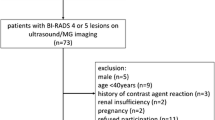Abstract
To investigate the usefulness of computed tomography (CT) with skin-marker placement in determining the excision area and decreasing the positive or close margin rates in breast-conserving surgery (BCS). Multidetector-row helical computed tomography (MDCT) mapping images were reconstructed in subjects (n = 117) diagnosed with primary breast cancer who had undergone MDCT using CT skin markers. Serial 5-mm-thick slices prepared from the surgical specimen were used for pathological analyses. A “positive margin” was defined as the presence of malignant cells at the surgical margin, and a “close margin” as a tumor within 5 mm of the surgical margin. The rates of positive and close margins were calculated. We identified the lesions in 111 of 117 cases (94.9%) on MDCT. Of these, 93 underwent BCS under the guidance of MDCT mapping and the remaining 18 underwent mastectomy. Among the 93 cases, 6 (6.5%) had positive or close margins and were diagnosed with ductal carcinoma in situ of low nuclear grade. MDCT mapping with a CT skin marker is feasible for simulating surgical positioning and determining the excision area. MDCT mapping could decrease the positive and close margin rates in BCS.




Similar content being viewed by others
References
Singletary SE (2002) Surgical margins in patients with early-stage breast cancer treated with breast conservation therapy. Am J Surg 184:383–393
Inoue T, Tamaki Y, Hamada S et al (2005) Usefulness of three-dimensional multidetector-row CT images for preoperative evaluation of tumor extension in primary breast cancer patients. Breast Cancer Res Treat 89:119–125
Hata T, Takahashi H, Watanabe K et al (2004) Magnetic resonance imaging for preoperative evaluation of breast cancer: a comparative study with mammography and ultrasonography. J Am Coll Surg 198:190–197
Brand IR, Sapherson DA, Brown TS (1993) Breast imaging in women under 35 with symptomatic breast disease. Br J Radiol 66:394–397
Harms SE, Flamig DP, Hesley KL et al (1993) MR imaging of the breast with rotating delivery of excitation off resonance: clinical experience with pathologic correlation. Radiology 187:493–501
Orel SG, Schnall MD, LiVolsi VA, Troupin RH (1994) Suspicious breast lesions: MR imaging with radiologic-pathologic correlation. Radiology 190:485–493
Esserman L, Hylton N, George T, Weidner N (1999) Contrast-enhanced magnetic resonance imaging to assess tumor histopathology and angiogenesis in breast carcinoma. Breast J 5:13–21
Esserman L, Hylton N, Yassa L, Barclay J, Frankel S, Sickles E (1999) Utility of magnetic resonance imaging in the management of breast cancer: evidence for improved preoperative staging. J Clin Oncol 17:110–119
Akashi-Tanaka S, Fukutomi T, Miyakawa K, Uchiyama N, Tsuda H (1998) Diagnostic value of contrast-enhanced computed tomography for diagnosing the intraductal component of breast cancer. Breast Cancer Res Treat 49:79–86
Uematsu T, Sano M, Homma K, Shiiba M, Kobayashi S (2001) Three-dimensional helical CT of the breast: accuracy for measuring extent of breast cancer candidates for breast conserving surgery. Breast Cancer Res Treat 65:249–257
Tozaki M, Kawakami M, Suzuki M, Uchida K, Yamashita A, Fukuda K (2003) Diagnosis of Tis/T1 breast cancer extent by multislice helical CT: a novel classification of tumor distribution. Radiat Med 21:187–192
Uematsu T, Sano M, Homma K, Sato N (2004) Value of three-dimensional helical CT image-guided planning for made-to-order lumpectomy in breast cancer patients. Breast J 10:33–37
Makino H, Sano M, Uematsu T et al (1998) Role of image diagnosis in breast conserving surgery—simulation of surgery using helical CT. Jpn J Breast Cancer 13:447–453
Iwase T (2004) A decision on the extent of breast resection in breast-conserving surgery. Jpn J Clin Surg 59:1123–1128
Makita M, Gomi N, Tachikawa T et al (2004) CT guided thermoplastic assisted segmentectomy. Jpn J Breast Cancer 19:142–149
Shimauchi A, Yamada T, Sato A et al (2006) Comparison of MDCT and MRI for evaluating the intraductal component of breast cancer. Am J Roentgenol 187:322–329
Uematsu T, Yuen S, Kasami M, Uchida Y (2008) Comparison of magnetic resonance imaging, multidetector row computed tomography, ultrasonography, and mammography for tumor extension of breast cancer. Breast Cancer Res Treat. doi:10.1007/s10549-008-9890-y
Nakahara H, Namba K, Wakamatsu H et al (2002) Extension of breast cancer: comparison of CT and MRI. Radiat Med 20:17–23
Hiramatsu H, Enomoto K, Ikeda et al (1999) Three-dimensional helical CT for treatment planning of breast cancer. Radiat Med 17:35–40
Uematsu T, Sano M, Homma K, Sato N (2002) Comparison between high-resolution helical CT and pathology in breast examination. Acta Radiol 43:385–390
Rosen EL, Smith-Foley SA, DeMartini WB, Eby PR, Peacock S, Lehman CD (2007) BI-RADS MRI enhancement characteristics of ductal carcinoma in situ. Breast J 13:545–550
Mumtaz H, Hall-Craggs MA, Davidson T et al (1997) Staging of symptomatic primary breast cancer with MR imaging. Am J Roentgenol 169:417–424
Yamauchi C, Mitsumori M, Sai H et al (2007) Patterns of care study of breast-conserving therapy in Japan: comparison of the treatment process between 1995–1997 and 1999–2001 surveys. Jpn J Clin Oncol 37:737–743
Tartter PI, Kaplan J, Bleiweiss I et al (2000) Lumpectomy margins, reexcision, and local recurrence of breast cancer. Am J Surg 179:81–85
Ciccarelli G, Di Virgilio MR, Menna S et al (2007) Radiography of the surgical specimen in early stage breast lesions: diagnostic reliability in the analysis of the resection margins. Radiol Med (Torino) 112:366–376
Amemiya A, Kondo M (1999) Breast conservation therapy based on liberal selection criteria and less extensive surgery analysis of cases with positive margins. Jpn J Breast Cancer 14:324–331
Akashi-Tanaka S, Fukutomi T, Miyakawa K et al (2001) Contrast-enhanced computed tomography for diagnosing the intraductal component and small invasive foci of breast cancer. Breast Cancer 8:10–15
Maeda Y, Hata Y, Matsuoka S et al (2004) Utility of three-dimensional helical CT in the diagnosis of breast cancer. Jpn J Surg Assoc 65:581–586
Acknowledgements
We thank the staff at the Department of Radiology for technical assistance in manuscript preparation.
Author information
Authors and Affiliations
Corresponding author
Rights and permissions
About this article
Cite this article
Harada-Shoji, N., Yamada, T., Ishida, T. et al. Usefulness of lesion image mapping with multidetector-row helical computed tomography using a dedicated skin marker in breast-conserving surgery. Eur Radiol 19, 868–874 (2009). https://doi.org/10.1007/s00330-008-1220-6
Received:
Revised:
Accepted:
Published:
Issue Date:
DOI: https://doi.org/10.1007/s00330-008-1220-6




